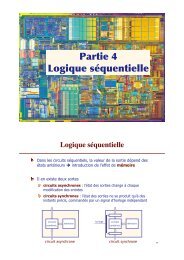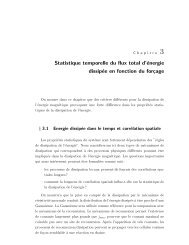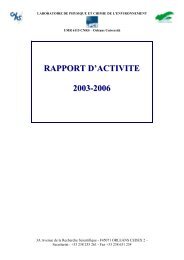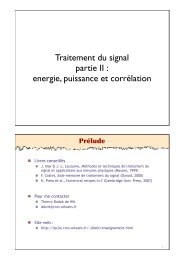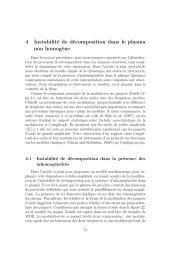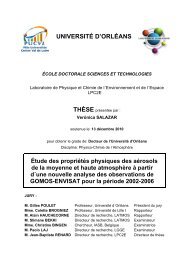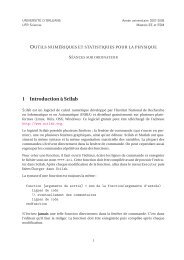UNIVERSITÉ D'ORLÉANS - Laboratoire de physique et chimie de l ...
UNIVERSITÉ D'ORLÉANS - Laboratoire de physique et chimie de l ...
UNIVERSITÉ D'ORLÉANS - Laboratoire de physique et chimie de l ...
Create successful ePaper yourself
Turn your PDF publications into a flip-book with our unique Google optimized e-Paper software.
PV fields on isentropic surfaces. These PV maps give information about the location of the<br />
SPIRALE measurements relative to the different dynamical barriers. Distributions of PV have<br />
been calculated at the time of SPIRALE measurements in the 440 K to 500 K range<br />
(corresponding to the 19–21 km altitu<strong>de</strong> range) every 5 K. Figure 5 shows the PV maps<br />
<strong>de</strong>rived at 465 K (~19.5 km) on (a) 22 June 2005 and (b) 10 June 2008. On each map, the<br />
instrument location is indicated by a white cross. It appears that SPIRALE sampled air masses<br />
of low PV values on 22 June 2005 and was located on the south si<strong>de</strong> of the strong dynamical<br />
barrier (marked by a high PV contour gradient around 0–5°N). On 10 June 2008 the situation<br />
was strongly different as SPIRALE sampled air masses on the north si<strong>de</strong> of this barrier<br />
(marked by a high PV contour gradient around 15–20°S) with much higher PV values.<br />
Interestingly, the PV map of 10 June 2008 does not show a clear filament coming from mid-<br />
latitu<strong>de</strong>s as higher HCl values could have suggested. Another explanation for this<br />
phenomenon could come from the influence of the different quasi biennal oscillation (QBO)<br />
phases in which the two flights occurred. In the altitu<strong>de</strong> range of interest, the 2008 flight took<br />
place in a well-established easterly phase whereas in 2005 the flight was performed at the end<br />
of a westerly QBO-phase (see http://www.geo.fu-<br />
berlin.<strong>de</strong>/en/m<strong>et</strong>/ag/strat/produkte/qbo/in<strong>de</strong>x.html). Based on the study of Chen <strong>et</strong> al. (2005),<br />
for pressures larger than 50 hPa (below ~21 km), the easterly and westerly QBO phase are not<br />
associated with the same induced circulation. During the easterly phase, the tropical region is<br />
characterized by a convergent wind flow from higher latitu<strong>de</strong>s. As a consequence, the<br />
SPIRALE instrument might have captured the effect of this easterly QBO phase with air<br />
masses un<strong>de</strong>r the influence of mid-latitu<strong>de</strong> air at these low altitu<strong>de</strong> levels leading to higher<br />
HCl values.<br />
B<strong>et</strong>ween 21 and 30 km, both the 2005 and 2008 SPIRALE measurements agree very well<br />
with each other (see Fig. 4). This good consistency suggests an atmospheric state without<br />
strong dynamical and chemical perturbations over the middle tropical stratosphere. At these<br />
altitu<strong>de</strong>s, our measurements were ma<strong>de</strong> in very favourable conditions for direct absorption<br />
<strong>de</strong>tection because of the higher HCl vmr values and the lower pressure reducing the ro-<br />
vibrational line broadness. We find vmr values ranging from 0.37±0.05 ppbv at 21 km to<br />
1.49±0.09 ppbv at 30 km for 2005 and 2008, on average. These results are in fairly good<br />
agreement with previous measurements for 30°S–30°N during 2004 by ACE-FTS, yielding<br />
0.50±0.14 ppbv of HCl at 20 km and 1.8±0.3 ppbv at 30 km (Nassar <strong>et</strong> al., 2006; Mahieu <strong>et</strong><br />
al., 2008), with ACE-FTS measuring about 20% more than SPIRALE at 30 km. Additionally<br />
121



